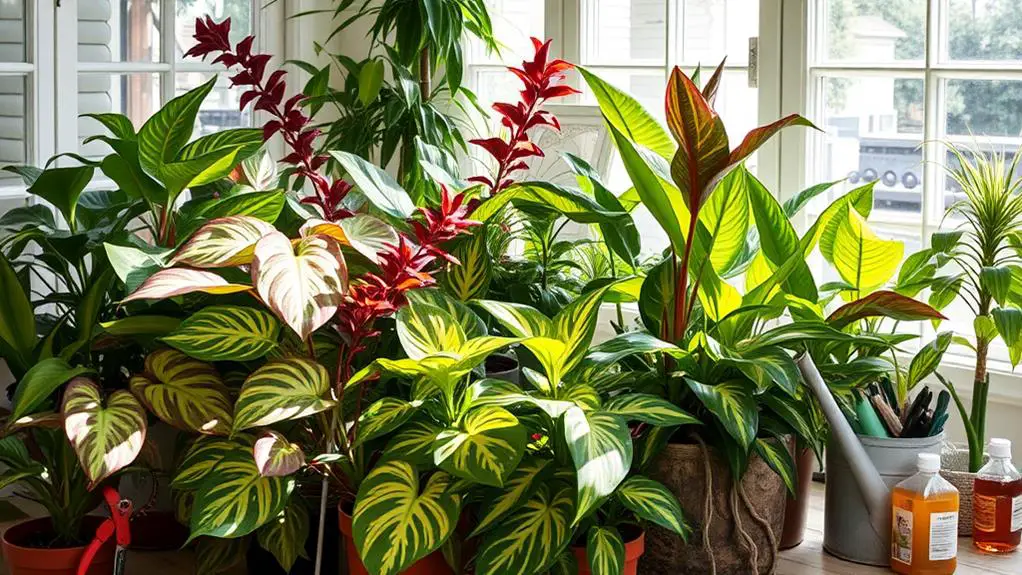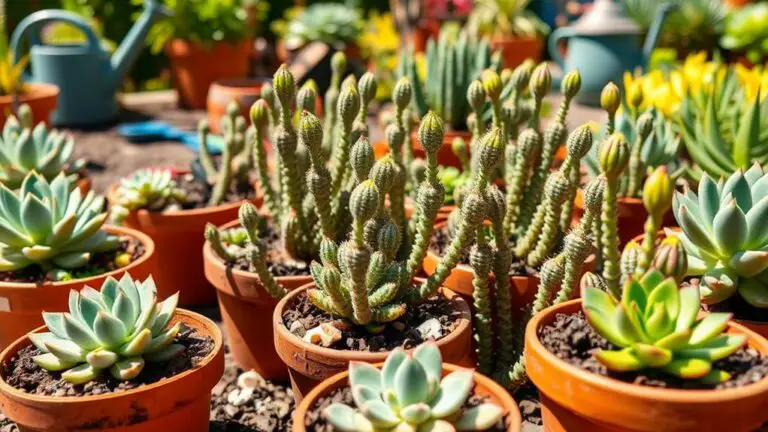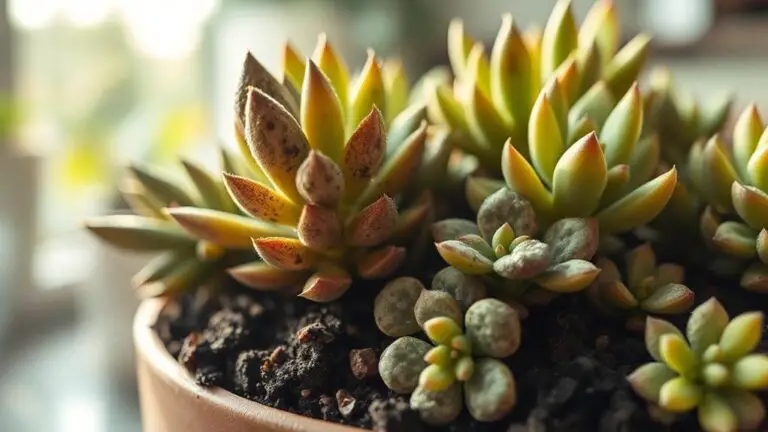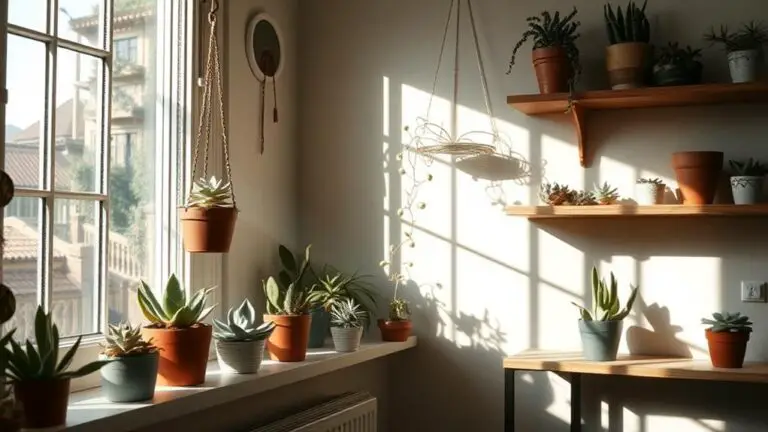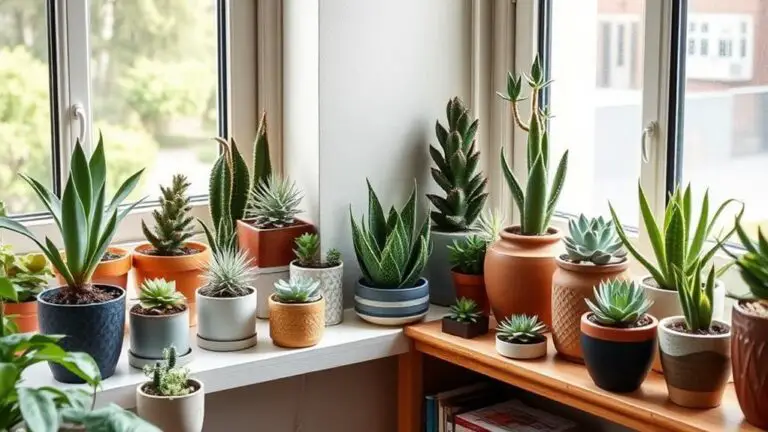10 Tips to Induce and Maintain Variegation in Your Houseplants
When you're aiming to induce and maintain variegation in your houseplants, understanding the basics is essential. You'll want to start by selecting the right species—those that are naturally variegated and stable. However, there's more to it than just choosing the right plant. Optimizing light exposure and maintaining consistent temperature can make a significant difference. Proper watering techniques and wise fertilization are also vital. Have you ever wondered how to effectively propagate variegated sections or manage plant stress to sustain that beautiful variegation? Let's explore the steps to transform your indoor garden.
Understand Variegation Basics
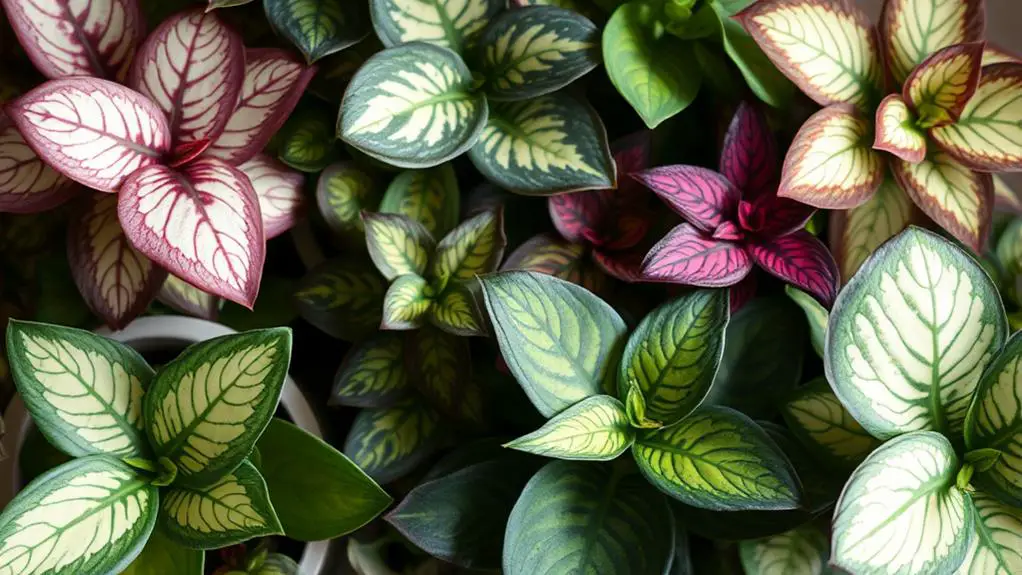
Variegation in houseplants is a fascinating phenomenon resulting from genetic mutations that disrupt chlorophyll production, creating unique patterns of color on the leaves. These patterns, like white or yellow patches, make your plants stand out. Understanding variegation basics is key.
Different types of variegation include marginal, central, mosaic, sectorial, and blotched, each with specific color arrangements.
Light plays a big role in maintaining variegation. Too much light can bleach the leaves, while too little can cause the variegation to fade.
Genetic mutations are the root cause, and environmental factors like temperature and nutrient levels also affect stability.
Keep an eye out for reversion, where leaves turn solid green, and use cuttings from variegated sections for propagation.
Choose Suitable Plants

When choosing plants for their variegation, start with popular species like Monstera deliciosa Albo-Variegata, Pothos (Marble Queen), and Snake Plant (Laurentii).
Look for plants that already show strong variegation traits, such as Aglaonema and Calathea, known for their colorful leaves.
Be sure to pick healthy plants that thrive in bright, indirect light to keep their beautiful patterns.
Best Variegated Species
Choosing the best variegated houseplants can transform your indoor space with unique patterns and vibrant colors.
Variegated houseplants have a unique beauty due to their varied chlorophyll production, setting them apart from normal plants. Here are some excellent choices:
- Monstera deliciosa Albo-Variegata: Features large leaves with dramatic white or cream patches.
- Pothos (Epipremnum aureum) Marble Queen: Beginner-friendly with beautiful splashes of yellow and white.
- Snake Plant (Sansevieria trifasciata) Laurentii: Known for its resilience and attractive yellow edges.
- Spider Plant Variegated (Chlorophytum comosum): Exhibits white-striped leaves, perfect for hanging baskets.
These plants not only transform your space but also offer unique visual appeal.
Start your collection today and enjoy the natural beauty they bring to your home!
Identifying Variegation Traits
Identifying variegation traits is key to selecting the right houseplants for your indoor garden. Look for variegation in plants that show stable variegation, confirming the patterns on their leaves remain consistent.
Popular choices include Monstera deliciosa Albo-Variegata, Pothos (Marble Queen), and Calathea, all known for their unique variegation.
Traits like marginal variegation, such as yellow edges in a Snake Plant, or mosaic variegation, like patches on Pothos leaves, add diversity to your collection.
Opt for plants with a history of stable variegation to confirm they retain their unique traits. Younger plants often show more pronounced variegation, so observe their growth stage carefully to maintain these beautiful patterns.
Beginner-Friendly Options
Building on your understanding of variegation traits, let's explore some beginner-friendly houseplants that showcase stunning variegation without demanding expert care.
These variegated plants are perfect for adding unique patterns and colors to your home while being easy to maintain.
- Pothos (Epipremnum aureum): Thrives in different light conditions with popular varieties like Marble Queen.
- Snake Plant (Sansevieria trifasciata): The Laurentii variety tolerates low light and infrequent watering, featuring striking yellow edges.
- Spider Plant Variegated (Chlorophytum comosum): Adapts well to various environments with its white-striped leaves.
- Monstera deliciosa Albo-Variegata: Requires more light and humidity but offers dramatic white patches.
These options help you keep the plant healthy while producing chlorophyll in light green areas.
Optimize Light Exposure
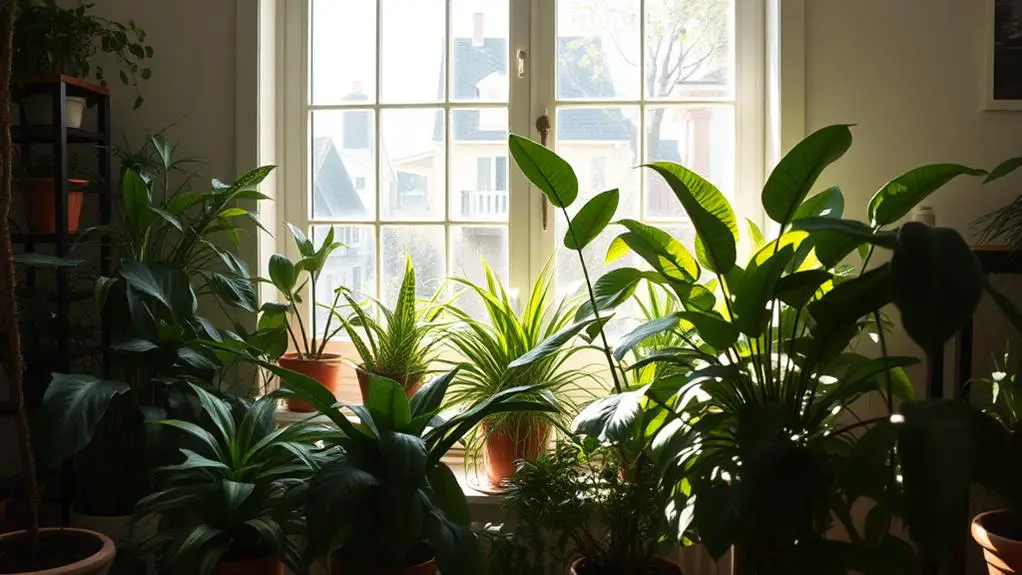
To keep your variegated houseplants vibrant and healthy, optimizing light exposure is crucial. Variegated plants need bright, indirect light to maintain their unique patterns. Too little light can cause an increase in green leaves, as the plant produces more chlorophyll to compensate.
| Tip | Action | Benefit |
|---|---|---|
| Light Type | Use indirect light | Maintains variegation |
| Location | Near filtered windows | Prevents scorching |
| Rotation | Rotate regularly | Guarantees even growth |
| Seasonal Adjustments | Monitor light levels | Adapts to daylight changes |
| Acclimation | Gradually move to brighter spots | Prevents plant stress |
Place your plants near filtered windows and rotate them often to guarantee even exposure. Adjust light settings seasonally and consider supplemental lights in darker months to keep your plants thriving.
Maintain Temperature Stability

Maintaining temperature stability is crucial for the health and vibrancy of variegated houseplants. Variegated ones thrive in a consistent temperature range of 18°C to 27°C. Sudden temperature changes can stress the plant and cause it to lose its unique coloration.
To guarantee your plants stay healthy, follow these tips:
- Keep plants away from heat sources: Avoid placing them near vents or ovens.
- Avoid cold drafts: Position your plants away from windows and doors during colder months.
- Monitor temperature regularly: Regular checks can help you maintain a stable environment.
- Create a stable environment: Maintain minimal temperature fluctuations to support your plant's overall vitality.
Proper Watering Techniques

To keep your plant's beautiful variegation, you need a consistent watering schedule that avoids overwatering hazards.
Use distilled water to prevent mineral buildup, and let the top inch of soil dry out before rewatering.
Consistent Watering Schedule
When caring for variegated houseplants, a consistent watering schedule is essential because it directly affects their unique leaf patterns and overall health.
Proper hydration supports chlorophyll production without causing excessive green leaf growth, which can diminish variegated patterns. To keep your plants thriving:
- Monitor moisture levels: Water only when the top inch of soil feels dry.
- Adjust for conditions: Change your watering frequency based on humidity and temperature.
- Check for stress signs: Look for yellowing or drooping leaves, which can indicate overwatering or underwatering.
- Guarantee proper drainage: Use well-draining soil to prevent waterlogging and root rot.
Following these tips helps maintain your plant's beautiful variegation and guarantees they stay healthy and vibrant.
Avoid Overwatering Hazards
After establishing a consistent watering schedule, it's vital to address the hazards of overwatering to keep your variegated houseplants healthy and vibrant.
Overwatering can lead to root rot, which may increase chlorophyll production and diminish your plant's variegation. To prevent this, make sure your potting mix has good drainage. Let the top inch of soil dry out between watering sessions to maintain a balanced moisture level.
Monitoring humidity levels is important; too much moisture can worsen the risk of root rot and loss of variegation. Adjust your watering frequency based on the seasons: in warmer months, water more often; in cooler months, water less.
Keeping these tips in mind will help your plants thrive.
Use Distilled Water
You'll find that using distilled water for your variegated houseplants can make a noticeable difference in their health and appearance.
Distilled water eliminates chlorine and other chemicals that can harm plant health and growth. It also maintains a neutral pH level, ensuring the soil stays balanced, which is vital for preserving variegation. Additionally, it helps prevent mineral deposits in the soil, reducing root stress and supporting healthy variegation.
Remember to monitor the moisture level to avoid overwatering, which can cause root rot.
Here are some key benefits of distilled water for your plants:
- Eliminates harmful chemicals
- Maintains neutral soil pH
- Prevents mineral buildup
- Supports balanced variegation
Using distilled water gives your variegated plants the best chance to thrive and look beautiful.
Prune Regularly
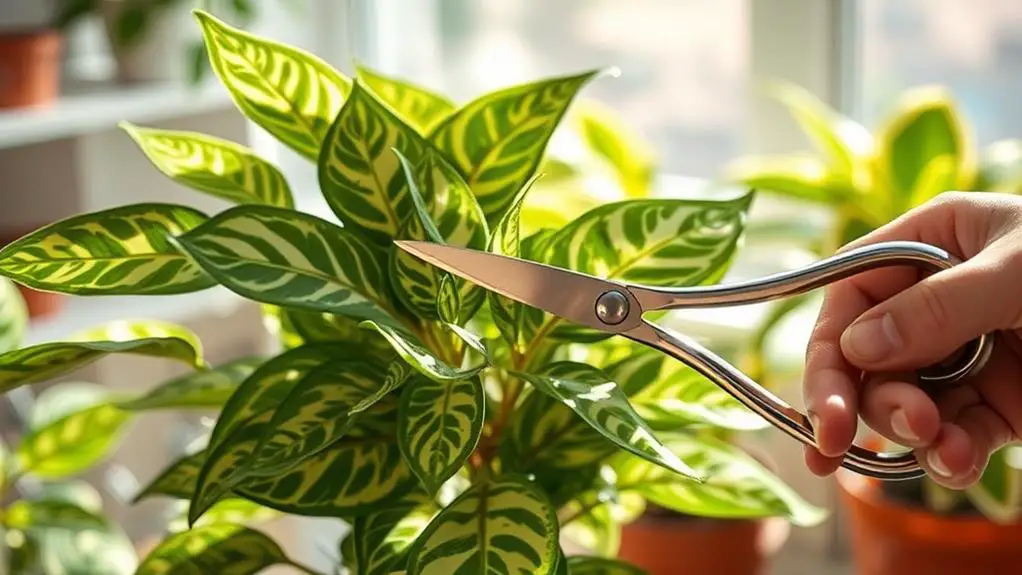
To keep your variegated houseplants looking their best, regular pruning is essential. When you prune regularly, you remove non-variegated leaves, which encourages the growth of variegated shoots. This enhances your plant's health and appearance by stimulating hormone production and promoting stronger variegation in new growth. Use clean, sharp tools to avoid damage and disease.
Pruning in early spring can lead to the best results. Consistent trimming maintains balanced leaf distribution, boosting the plant's vigor. Here's a quick guide to help you:
| Action | Benefit |
|---|---|
| Remove non-variegated leaves | Encourages variegated shoots |
| Prune in early spring | Promotes new growth |
| Use sharp, clean tools | Prevents disease |
With these steps, your plants will thrive.
Fertilize Wisely
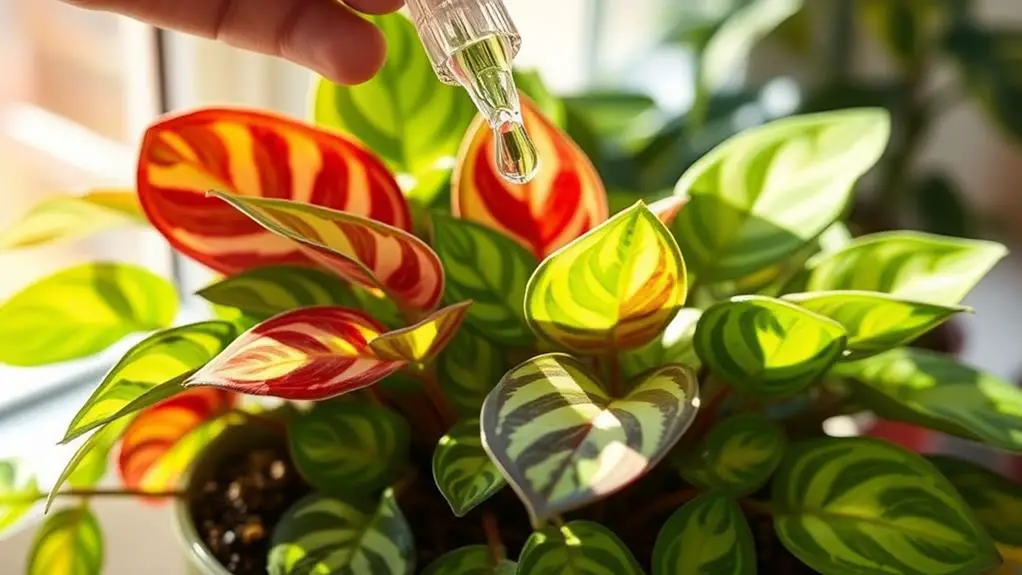
When it comes to maintaining the vibrant variegation of your houseplants, fertilizing wisely is crucial. Use a balanced fertilizer with equal parts nitrogen, phosphorus, and potassium to support overall plant health and promote variegation.
Apply it during the growing season, typically in spring and summer, to match the plant's active growth cycle. Remember, over-fertilizing can lead to excessive chlorophyll production, which may reduce variegation.
Here are some tips:
- Use slow-release fertilizers to provide a steady nutrient supply.
- Regularly test the soil to check nutrient levels.
- Monitor fertilization frequency to avoid nutrient imbalances.
- Adjust feeding schedules based on plant growth and health.
Following these guidelines guarantees your plants stay colorful and healthy.
Monitor Environmental Conditions
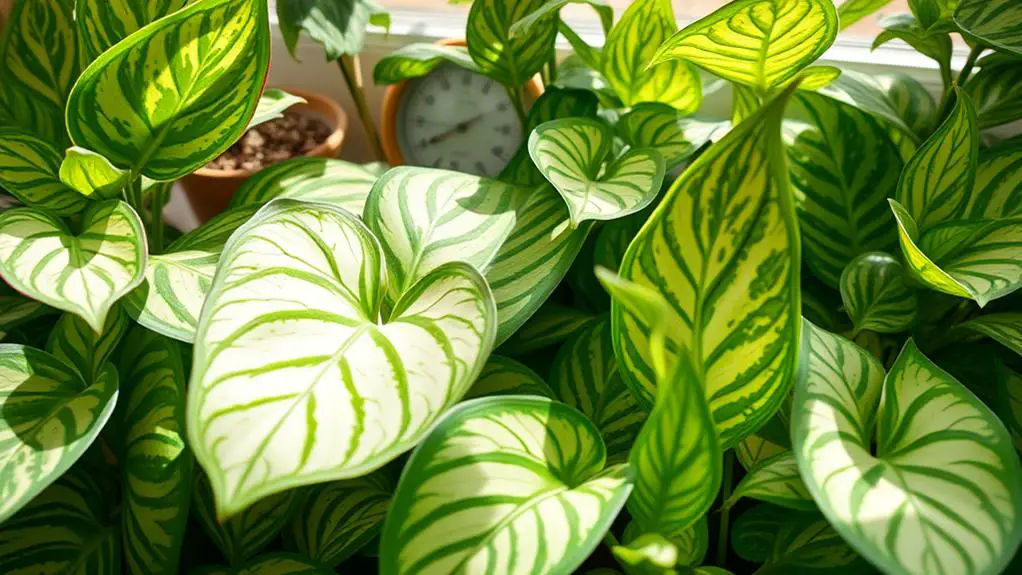
To keep your variegated houseplants thriving, you'll need to monitor their environmental conditions closely.
Check that they get bright, indirect sunlight to maintain the right chlorophyll balance, and keep the temperature steady between 18°C to 27°C.
These steps will help prevent your plant's leaves from losing their beautiful variegation.
Optimal Light Levels
Achieving the perfect balance of light is essential for maintaining the vibrant variegation in your houseplants.
Variegated foliage needs bright, indirect light to keep its unique patterns and produce chlorophyll. Insufficient light can cause an increase in green leaves, risking the loss of variegation.
Direct sunlight should be avoided as it can scorch the lighter areas of the leaves. Keep an eye on your plant's light exposure and adjust its position as needed.
- Guarantee bright, indirect light for ideal light levels.
- Avoid direct sunlight to prevent leaf scorch.
- Monitor light exposure to maintain variegation.
- Adjust plant placement if variegation starts to fade.
Consistent Temperature Control
A key factor for maintaining the vibrant variegation in your houseplants is consistent temperature control. Keeping temperatures between 18°C and 27°C (64°F to 80°F) is essential. Fluctuations can stress your plants and lead to a loss of variegation.
Avoid placing them near vents, ovens, or drafty windows, as sudden temperature changes can negatively affect chlorophyll production. Regularly monitor environmental conditions to guarantee consistent growth and prevent stress-induced changes in leaf coloration.
A stable temperature environment helps reduce the risk of pests and diseases. Using a thermometer or digital hygrometer can help you track temperature and humidity levels, making sure they stay within the ideal range. This will support healthier, more vibrant variegated growth.
Propagate Variegated Sections
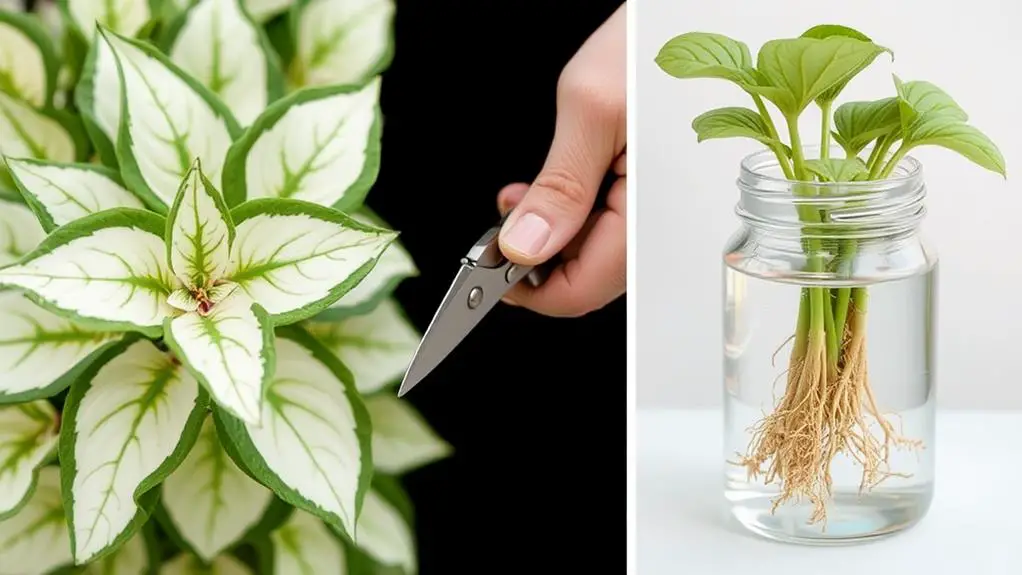
Selecting cuttings that exhibit strong variegation is essential when propagating variegated plants, as this increases the likelihood of retaining the unique coloration in new growth. Make certain each cutting includes at least one node for root development.
Carefully separate root sections during propagation via division to maintain variegation.
To enhance your success, follow these tips:
- Use a well-draining potting mix to prevent root rot.
- Monitor environmental stressors to avoid reversion.
- Ascertain stable light and humidity levels.
- Check new growth for variegation retention regularly.
These steps will help you propagate variegated sections effectively.
By paying close attention to light, humidity, and soil conditions, you'll support the successful growth of your beautiful, variegated houseplants.
Keep experimenting and learning!
Manage Plant Stress

After successfully propagating variegated sections, it's important to manage plant stress to guarantee your plants thrive. Start by keeping humidity levels stable, as fluctuations can cause variegated leaves to revert to green. Avoid overwatering and underwatering by maintaining consistent watering practices. Monitor the temperature, aiming for 18°C to 27°C to prevent stress from extreme conditions. Regularly check for pests and diseases, as infestations can harm the health and appearance of your variegated leaves. Prune non-variegated growth to relieve plant stress and encourage new variegated shoots.
| Key Action | Benefit |
|---|---|
| Maintain Humidity Levels | Prevents leaf reversion |
| Consistent Watering | Reduces stress, aids variegation |
| Monitor Temperature | Avoids extreme heat/cold stress |
| Check for Pests/Diseases | Keeps plants healthy |
Frequently Asked Questions
How Do You Encourage Variegation in Houseplants?
You encourage variegation by providing bright, indirect light, pruning non-variegated leaves, maintaining stable conditions, using balanced fertilizers sparingly, and propagating from well-variegated cuttings. These steps help keep your houseplants' unique color patterns vibrant and healthy.
How to Induce Variegation in Plants?
You can induce variegation by using selective breeding techniques or tissue culture methods. Introducing specific plant viruses might also work but can harm the plant. Environmental stressors like fluctuating temperatures may help, though results are unpredictable.
How to Get Variegation Back in Plants?
Make certain your plant gets bright, indirect light to encourage variegation. Prune non-variegated growth and monitor nutrient levels. Avoid over-fertilization and maintain stable temperatures. Watch for solid green leaves and act quickly to preserve variegation.
What Causes More Variegation in Plants?
More variegation in plants is caused by genetic mutations, increased light, and stable temperatures. Stress factors and pruning non-variegated growth also help. Tissue culture techniques can propagate highly variegated specimens, making your plants look more vibrant.
Conclusion
You've got all the tools you need to keep your houseplants beautifully variegated! Just remember to give them bright, indirect light and keep an eye on temperature and watering. Use a balanced fertilizer and don't forget to prune non-variegated leaves. Propagate from healthy sections and check for pests regularly. With these tips, you'll enjoy stunning, healthy plants. Keep going, and don't be afraid to experiment and learn what works best for your green friends!

